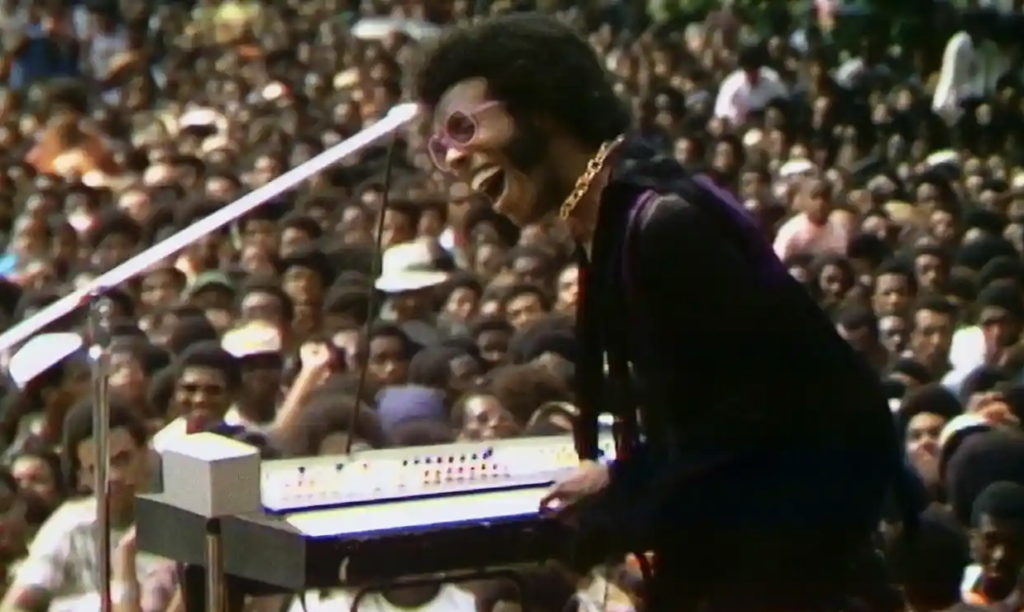Revelatory footage from the 1969 Harlem Cultural festival, crudely known for a while as the Black Woodstock, is brought to life in a spectacular new film

A still from Summer Of Soul. Photograph: Courtesy of Sundance Institute. Photo: Mass Distraction Media.
by Jordan Hamilton
The documentary Summer of Soul, now playing at the Amherst Cinema and streaming on Hulu, takes us to the 1969 Harlem Culture Festival which offered an extraordinary lineup of Black performers. The festival took place about the same time as Woodstock and was filmed. But the film languished in a basement for 50 years before Questlove Thompson recovered it and produced the film. Jordan Hoffman reviewed the film for The Guardian when it debuted at Cannes in January of 2021.
There’s a moment so striking and rich with power at the center of Ahmir “Questlove” Thompson’s Summer of Soul (…Or, When The Revolution Could Not Be Televised) that, while watching it, I actually forgot to breathe. It comes as Mavis Staples completes singing her section of the gospel song Take My Hand, Precious Lord. The audience is a packed Harlem park of almost exclusively African Americans who have just heard Dr Martin Luther King eulogized by a man who witnessed his assassination merely one year earlier, the electrifying Rev Jesse Jackson. And they know this was the slain leader’s favorite song.
As Staples brings the crowd to a near-stunned state of rapture, she hands the microphone to her mentor, Mahalia Jackson, who simply explodes with cathartic, full-bodied emotion. It goes beyond the category of mere singing, it’s an expression of grief, tenderness, community and healing. And what’s unbelievable is that this footage has been collecting dust in a basement for 50 years.
There’s a lot to talk about with Summer of Soul, and part of the story is how this extraordinary event was nearly forgotten. In 1969, a club singer, concert promoter, raconteur and very sharp dresser named Tony Lawrence convinced the New York City parks department to allow him to produce a series of summer concerts in Harlem’s Mount Morris Park (now known as Marcus Garvey Park). He found a sponsor in Maxwell House coffee and had an advocate in John Lindsey, the progressive-for-his-time mayor.
Part of the thinking was that the previous year saw riots in Harlem after King’s killing as well as a campus occupation at nearby Columbia University inspired, in part, by sympathetic whites upset the school was building what was essentially a racially segregated gymnasium in Morningside Park. It was determined that free concerts on six consecutive Sundays might release some necessary summer steam.
The shows, officially called the Harlem Culture festival, were a revelation. They were marvelously programmed to highlight different avenues of black music, from Motown pop to jazz to Afrobeat to gospel to psychedelic funk. The performers were all thrilled to play in the heart of Harlem, and witnesses reported that they’d never seen such a large gathering of black people in one spot before. The NYPD presence was minimized, and Black Panthers provided security for the talent.
Yet despite an unbelievable list of celebrated names like BB King, Stevie Wonder, the 5th Dimension, Sly and the Family Stone, Nina Simone, Max Roach and Abbey Lincoln, Hugh Masekela, Mongo Santamaria, Gladys Knight and the Pips, Babatunde Olatunji, David Ruffin of the Temptations and many more, the filmed record found no buyers. Meanwhile, the three-day festival of predominantly white acts a few hours north that occurred just as this was winding down, Woodstock, became synonymous with the counter-culture generation, and its documentary and soundtrack records made a fortune. Memories of the Harlem Culture festival faded.
As producers tried to sell this project back in the day they even branded it Black Woodstock. In some of the new interview footage you can read on the slate that Black Woodstock was Summer of Soul’s working title, but it’s good that it’s been changed. This document is special enough on its own without the comparison. The concerts had separate aims, and Questlove’s film is more than just archival footage. Different performances work as a conduit to different aspects of black musical tradition, be it blues, gospel or Berry Gordy-produced pop, and with each one we get a short, illuminating history.
Questlove turns to some of the surviving musicians (and other celebrities) to offer commentary while looking at the material again all these years later, but the most touching moments come from concertgoers who were simply kids from the neighborhood reflecting on a transformative summer. Watching Sly and the Family Stone burn down the stage with their closing number Higher, witness Musa Jackson is moved to tears. You can tell he’s been clinging to these hazy memories for 50 years, and may have even doubted himself when others called his stories of six weeks of free concerts in Harlem crazy. The lack of awareness of this event is another tragic example of black history being ignored. Only this time the record survived, and now we all get to share in it.
- Summer of Soul (…Or, When The Revolution Could Not Be Televised) is screening at the Sundance film festival and will be released later this year
- Thie article was amended on 30 January as Berry Gordy was originally mistakenly referred to as Berry Gordon
guardian.co.uk © Guardian News & Media Limited 2010
Published via the Guardian News Feed plugin for WordPress.

1 thought on “”